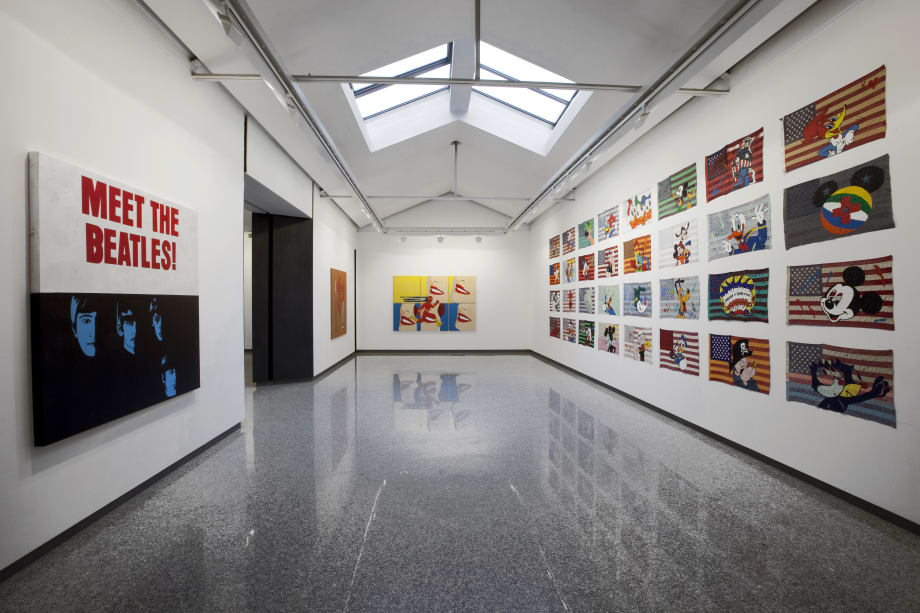Friday September 17th, Lorenzelli Arte will open the solo exhibition of Ronnie Cutrone, one of the most extraordinary interpreters of the American New Pop Art. Cutrone was influenced by one of the most alive and stimulating environments of the New York culture. As the assistant of Andy Warhol during the golden years in the Factory, from 1972 until 1980, he was testimony of the american season of graffiti and of the New Pop in the ‘80's. He has absorbed the explosive energy, but above all, he has proven Warhal's intuitions of the bond between art and contemporary society using people's imaginations for critical analysis. The exhibition, cured by Matteo Lorenzelli, Ivan Quaroni and Elena Forin, will be presented in three halls of the gallery. A large number of works from the last decade offer the rare occasion to admire some cycles of work next to one another that have never been exposed all together at once in Italy: the Cell Girls, the Transformer and the Pop Shots.
“The images that have always attracted me most were the images of Pop culture, and when they celebrate society as well as when they criticize society or even simply observe society” and “I have decided to paint the world as if it was to exist through it's symbols. For that, I have chosen the flags, fantastic pieces of fabric full with symbols of life and death, of pride and invisible borders, and of blood and souls (R. Cutrone)”.
The theme, Pop Shots, where the flags are not only the medium on which he paints his stories, but above all are the metaphor of a geopolitical fact, the representation of a scenario, and of a theatre in which drama and comedies of the contemporary are used. Cutrone shows facts, objects, and symbols of the status quo, filtering these through the innocent view of his childhood. He retrieves the people's simplicity through the images and the celebration of society, it's consumerism, and mass culture. Starting from the artificial setting of historical pop, he created a new language that interprets, thanks to the use of an iconographic simple alphabet. Almost childish, the evolution of the contemporary reality: the feelings of the people and in the last decade, and after September 11th, the political and social issues. One example is from the series Cell Girls, began in 2004. This is a group of works, all together thirteen of which eleven canvases are 50x50 cm, and two larger works dedicated to the USA, 180x180 cm, and Afghanistan, 220x240 cm. They are portraits of female faces with Middle Eastern features, wearing the traditional Muslim veil with their mouth covered by a flag of one of the enemy states of Islamic terrorism. These works represent a turn in Cutrone's work because this time the work does not consist of a simple cartoon but an icon that transmits a very clear message of irrevocable anxiety. Just like the work, 6 FT Explosion with Phone Messages of 2005, that evokes the danger of other possible, violent attacks in a fantastic and spectacular language. Or Crusade, a symbolic painting in this case that depicts the symbol of Superman who is bleeding underneath a red cross in between a bullet and a lipstick, as a crucificiton of modern times.
In Cutrone's paintings, the dramatic aspect is supported by the light and ironic representation that has allowed him to observe the world with a view free of prejudices. One example is the politico, Look Better, made in 2006 and the tritico, ColorFast of 2010, that radiate a sort of impalpable sense of relaxation dictated by the sequence of five smiles of a woman turned upon a superhero, Flash Gordon, who runs on the canvas. Another example is the series entitled Transformer, began in 2004. This is a work in progress that the artist has been creating in the last five years and consists of pieces that reproduce on a larger scale the album covers of the music that was mainly listened to in the Factory, which was important for the artist himself; “I approached the idea of painting music as I might have done as a teenage boy painting his treasured record collection with his idols and obsessions. Rather naïve, almost silly, but with love” (Ronnie Cutrone). The visual impact of these works, where the writings have as much importance as the paintings, have graphic pictorial precision and at the same time are openly neglected through the often screaming and dripping colors. The first album cover painted by Cutrone is the cover of The Paragons Meet The Jesters that then were followed by the cult artists and musicians that are part of the story: “Sketches of Spain” by Miles Davis to Madonna with the cover “Erotica” to “Rhapsody in Blue” by Gershwin, to Jimi Hendrix with “Are you Experienced?” to Nino Rota with “Amarcord”. Reinterpreting the album covers that he loved, the artist accomplishes an emotional journey not only in his personal history but also in that of the Factory. “As a Pop artist”, he declared, “I have always been obsessed with cultural phenomena and by tendencies that in good or bad feed and transform a society”.
In occasion of the exhibition a catalogue will be published with texts by Ivan Quaroni and Elena Forin and 150 color reproductions.
Ronnie Cutrone : Pop, off the rack, by the slice, mix & match
Past exhibition

